Statistics and Metrics
EMQX provides metrics monitoring functions, based on which the operation and maintenance personnel can monitor the current service status and troubleshoot possible system malfunctions.
EMQX divides monitoring status into Statistics and Metrics.
- Statistics are integer-type gauges used to return a single value at the point of time the metric was requested.
- Metrics are integer-type counters used to measure simple incrementing and decrementing numbers, such as the number of bytes and messages sent or received.
EMQX provides users with multiple ways to view statistics and metrics. Most directly, you can view these data on the EMQX Dashboard. When it is not convenient to access the Dashboard, you can also get the data through REST API and system topic messages. Additionally, you can easily integrate the monitoring functions with your own monitoring system, see Integrate with Prometheus.
View Statistics on Dashboard
On EMQX Dashboard, click Monitoring -> Cluster Overview from the left navigation menu. On the Cluster Overview page, click the Nodes tab. Click the name of the node to see the statistics details on the right.
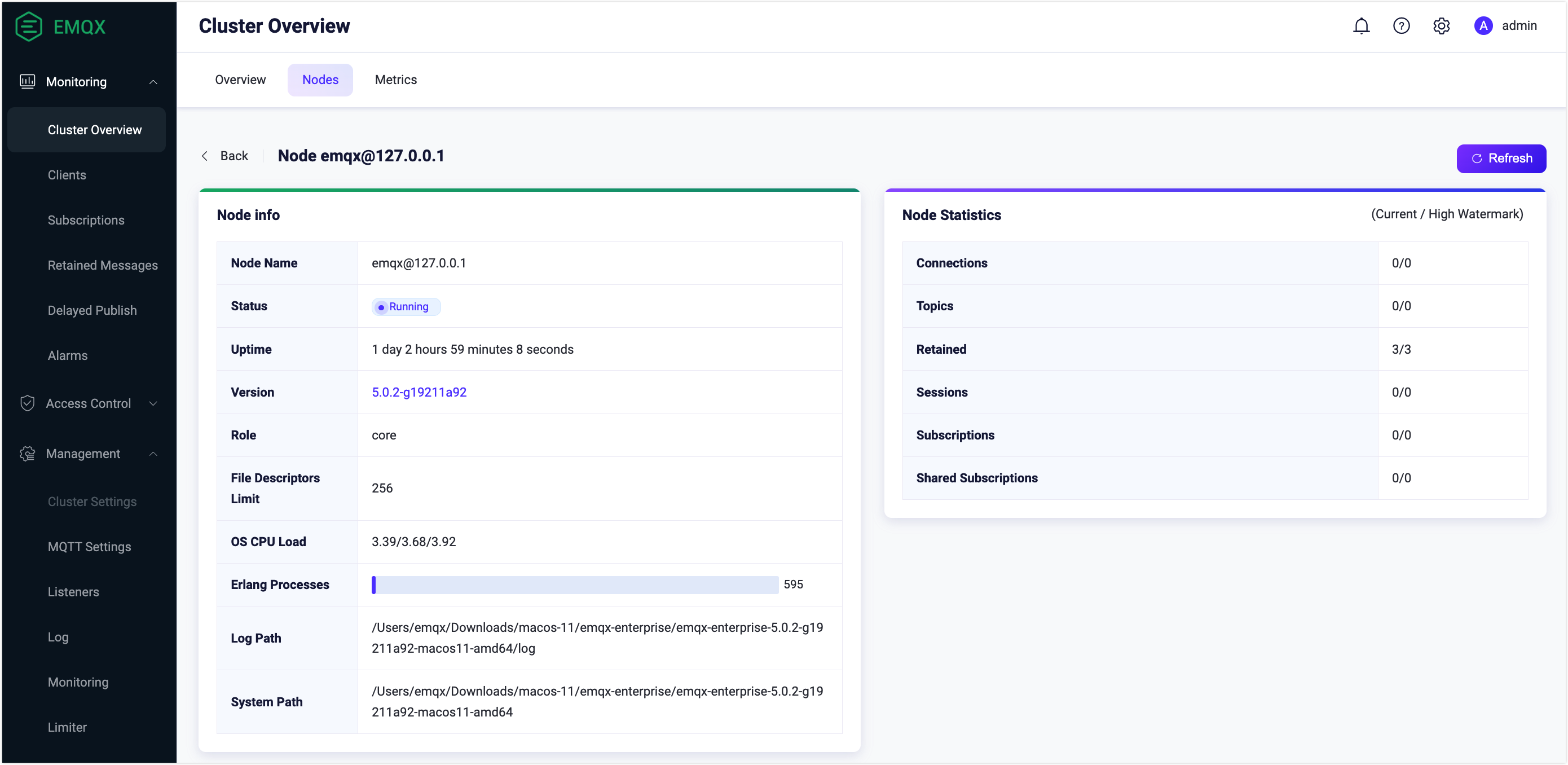
Statistics include two values: current values and historical maximums, for example, the current number of subscriptions and the historical maximum number of subscriptions. Here is the EMQX statistics list:
| Statistics | Description |
|---|---|
| connections.count | The number of current connections |
| connections.max | The historical maximum number of connections |
| live_connections.count | The number of currently live connections |
| live_connections.max | The historical maximum number of live connections |
| channels.count | The same as sessions.count |
| channels.max | The same as sessions.max |
| sessions.count | The number of current sessions |
| sessions.max | The historical maximum number of sessions |
| topics.count | The number of current topics |
| topics.max | The historical maximum number of topics |
| suboptions.count | The same as subscriptions.count |
| suboptions.max | The same as subscriptions.max |
| subscribers.count | The number of current subscribers |
| subscribers.max | The historical maximum number of subscribers |
| subscriptions.count | The number of current subscriptions, including shared subscriptions |
| subscriptions.max | The historical maximum number of subscriptions |
| subscriptions.shared.count | The number of current shared subscriptions |
| subscriptions.shared.max | The historical maximum number of shared subscriptions |
| retained.count | The number of currently retained messages |
| retained.max | The historical maximum number of retained messages |
| delayed.count | The number of currently delayed messages |
| delayed.max | The historical maximum number of delayed messages |
View Metrics on Dashboard
On EMQX Dashboard, click Monitoring -> Cluster Overview from the left navigation menu. On the Cluster Overview page, you can see metrics by clicking the Metrics tab. EMQX Metrics currently covers four dimensions: bytes, packets, messages, and events.
Connection and Session Metrics
You can see the event-related metrics for the cluster or node, such as client connection, connection sessions, and client access.
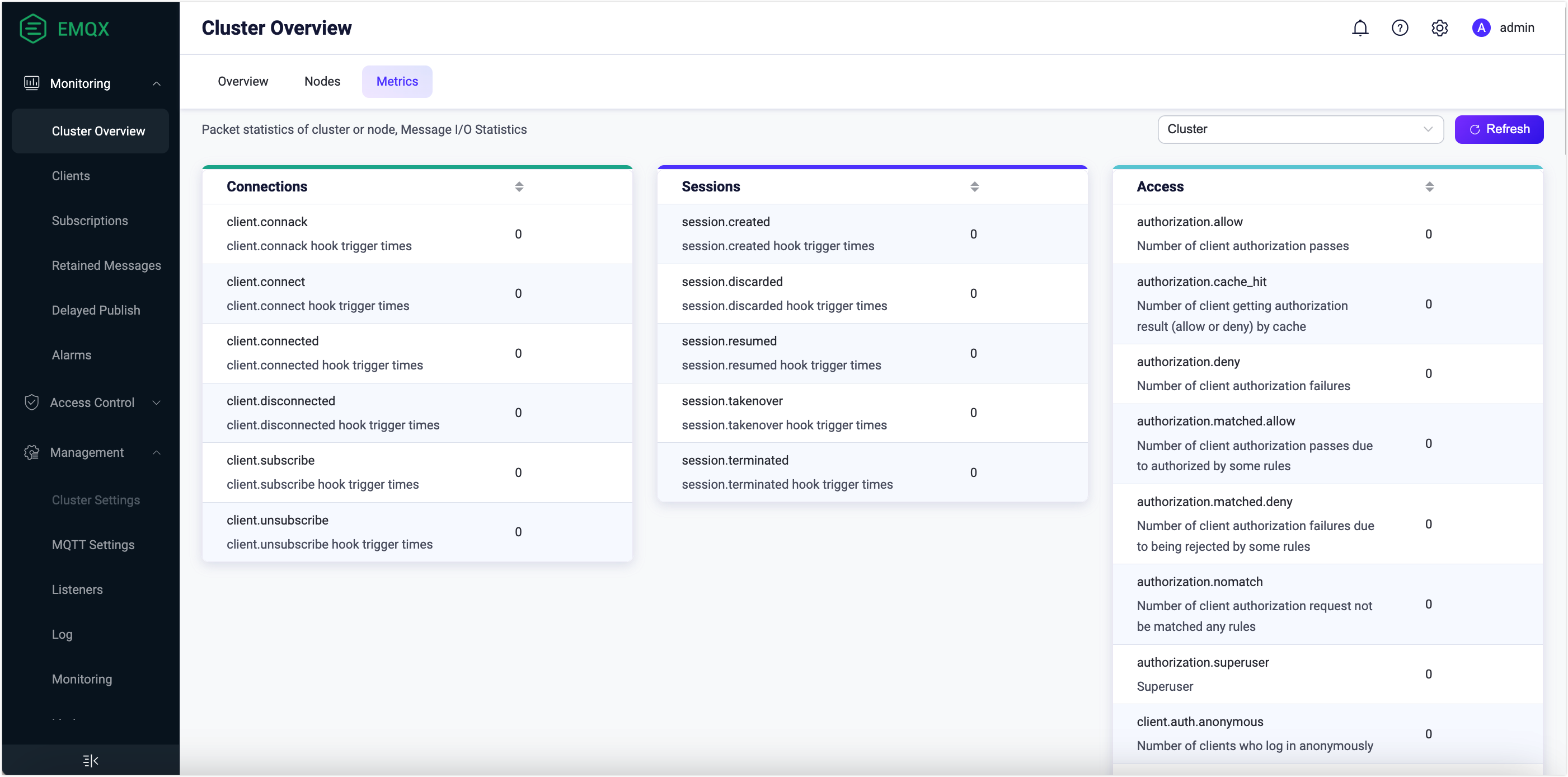
Connections
| Metrics | Description |
|---|---|
| client.connack | The number of connection acknowledgment (CONNACK) messages received by clients |
| client.connect | The number of connection requests from the client, including both successful and failed connection requests |
| client.connected | The number of client connections that have succeeded |
| client.disconnected | The number of client disconnections, including active and abnormal disconnections |
| client.subscribe | The number of successful subscriptions |
| client.unsubscribe | The number of successful unsubscriptions |
Sessions
| Metrics | Description |
|---|---|
| session.created | The number of sessions that have been created |
| session.discarded | The number of sessions that have been discarded |
| session.resumed | The number of sessions that have been resumed |
| session.takenover | The number of sessions that have been taken over |
| session.terminated | The number of sessions that have been terminated |
Access
| Metrics | Description |
|---|---|
| authorization.allow | The total number of client authorization passes, that is, the sum of cache hits (retrieved authorization results) and matched authorization requests (those corresponding to the policy rules). |
| authorization.deny | The total number of client authorization fails, that is, the sum of cache hits (retrieved authorization results) and unmatched authorization requests (those not corresponding to any policy rules). |
| authorization.matched.allow | The number of client authorization passes as per the rules |
| authorization.matched.deny | The number of client authorization fails as rejected by the rules |
| authorization.nomatch | The number of client authorization requests not matching any rules |
| authorization.cache_hit | The number of clients getting authorization results (allow or deny) by cache |
| authorization.superuser | The number of clients being authorized as superuser |
| client.auth.anonymous | The number of clients that log in anonymously |
| client.authenticate | The number of triggered authentication |
| client.authorize | The number of triggered authorization |
Messaging
Scroll down the Metrics page, and you can see message-related metrics, including bytes, packets, messages, and delivery.
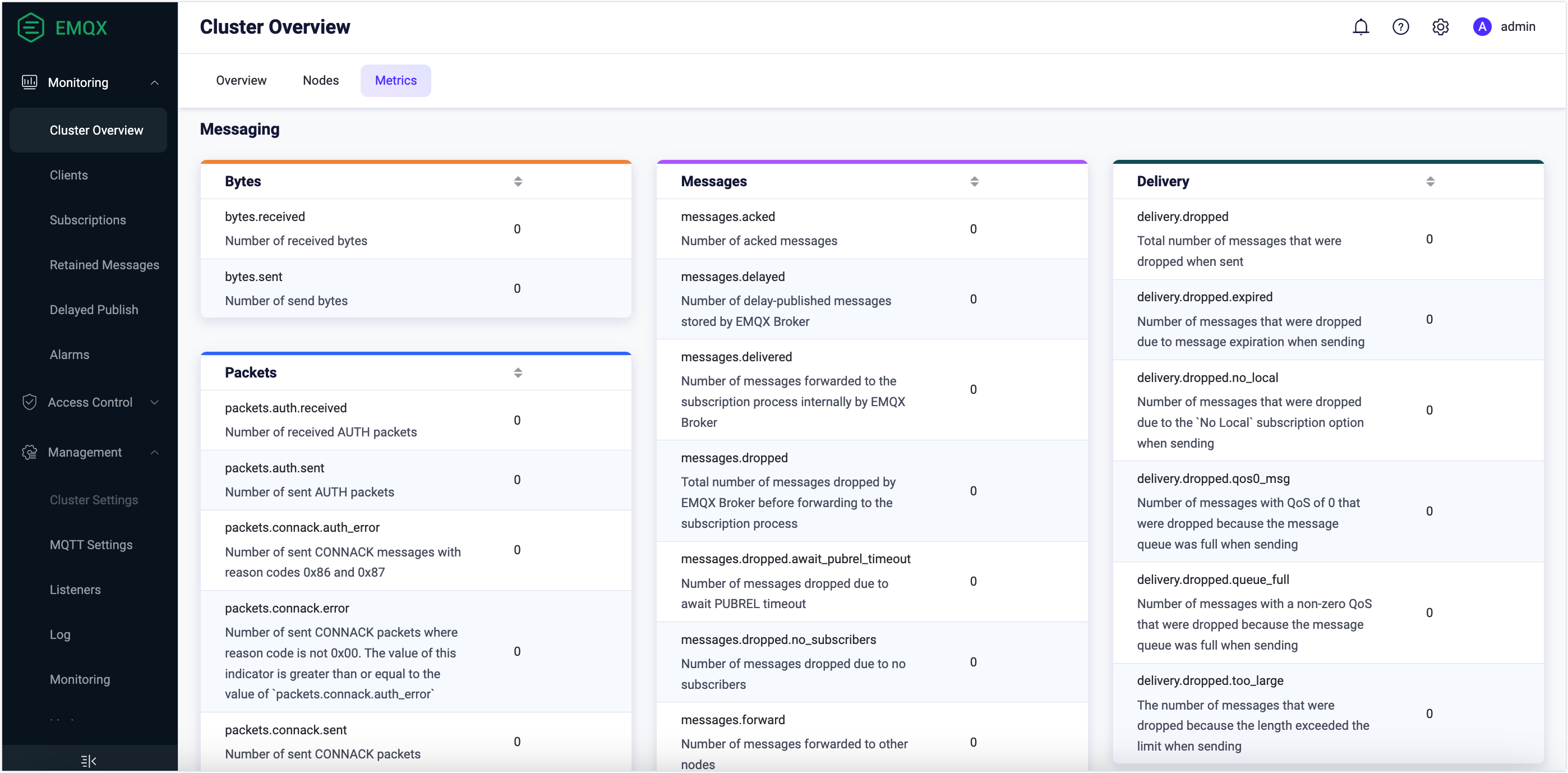
Bytes
| Metrics | Description |
|---|---|
| bytes.received | The number of bytes received |
| bytes.sent | The number of bytes sent |
Packets
| Metrics | Description |
|---|---|
| packets.received | The number of received packets |
| packets.sent | The number of sent packets |
| packets.connect.received | The number of received CONNECT packets |
| packets.connack.auth_error | The number of sent CONNACK messages with reason codes 0x86 and 0x87 |
| packets.connack.error | The number of sent CONNACK packets with reason codes apart from 0x00. The value of this indicator is greater than or equal to the value of packets.connack.auth_error |
| packets.connack.sent | The number of sent CONNACK packets |
| packets.publish.received | The number of received PUBLISH packets |
| packets.publish.sent | The number of sent PUBLISH packets |
| packets.publish.inuse | The number of received PUBLISH packets with occupied packet identifiers |
| packets.publish.auth_error | The number of received PUBLISH packets that failed the ACL check |
| packets.publish.error | The number of received PUBLISH packets that cannot be published |
| packets.publish.dropped | The number of PUBLISH packets that are discarded due to the receiving limit |
| packets.puback.received | The number of received PUBACK packets |
| packets.puback.sent | The number of sent PUBACK packets |
| packets.puback.inuse | The number of received PUBACK messages with occupied identifiers |
| packets.puback.missed | The number of received PUBACK packets with unknown identifiers |
| packets.pubrec.received | The number of received PUBREC packets |
| packets.pubrec.sent | The number of sent PUBREC packets |
| packets.pubrec.inuse | The number of received PUBREC messages with occupied identifiers |
| packets.pubrec.missed | The number of received PUBREC packets with unknown identifiers |
| packets.pubrel.received | The number of received PUBREL packets |
| packets.pubrel.sent | The number of sent PUBREL packets |
| packets.pubrel.missed | The number of received PUBREL packets with unknown identifiers |
| packets.pubcomp.received | The number of received PUBCOMP packets |
| packets.pubcomp.sent | The number of sent PUBCOMP packets |
| packets.pubcomp.inuse | The number of received PUBCOMP messages with occupied identifiers |
| packets.pubcomp.missed | The number of missed PUBCOMP packets |
| packets.subscribe.received | The number of received SUBSCRIBE packets |
| packets.subscribe.error | The number of received SUBSCRIBE packets with failed subscriptions |
| packets.subscribe.auth_error | The number of received SUBACK packets that failed the ACL check |
| packets.suback.sent | The number of sent SUBACK packets |
| packets.unsubscribe.received | The number of received UNSUBSCRIBE packets |
| packets.unsubscribe.error | The number of received UNSUBSCRIBE packets with failed unsubscriptions |
| packets.unsuback.sent | The number of sent UNSUBACK packets |
| packets.pingreq.received | The number of received PINGREQ packets |
| packets.pingresp.sent | The number of sent PUBRESP packets |
| packets.disconnect.received | The number of received DISCONNECT packets |
| packets.disconnect.sent | The number of sent DISCONNECT packets |
| packets.auth.received | The number of received AUTH packets |
| packets.auth.sent | The number of sent AUTH packets |
Message (PUBLISH packet)
| Metrics | Description |
|---|---|
| messages.acked | The number of acknowledged messages |
| messages.delayed | The number of messages for delayed publish that are stored by EMQX |
| messages.delivered | The number of messages forwarded to the subscription process internally by EMQX |
| messages.dropped | The total number of messages dropped by EMQX before forwarding to the subscription process |
| messages.dropped.no_subscribers | The number of messages dropped due to no subscribers |
| messages.dropped.await_pubrel_timeout | The number of messages dropped due to await PUBREL timeout |
| messages.forward | The number of messages forwarded to other nodes |
| messages.publish | The number of messages published in addition to system messages |
| messages.qos0.received | The number of QoS 0 messages received from clients |
| messages.qos1.received | The number of QoS 2 messages received from clients |
| messages.qos2.received | The number of QoS 1 messages received from clients |
| messages.qos0.sent | The number of QoS 0 messages sent to clients |
| messages.qos1.sent | The number of QoS 1 messages sent to clients |
| messages.qos2.sent | The number of QoS 2 messages sent to clients |
| messages.received | The number of messages received from the client, which is equal to the sum of messages.qos0.received, messages.qos1.received, and messages.qos2.received |
| messages.sent | The number of messages sent to the client, which is equal to the sum of messages.qos0.sent, messages.qos1.sent, and messages.qos2.sent |
Delivery
| Metrics | Description |
|---|---|
| delivery.dropped | The total number of dropped messages during transmission |
| delivery.dropped.expired | The number of dropped messages during transmission because the message is expired |
| delivery.dropped.no_local | The number of dropped messages during transmission due to the No Local subscription option |
| delivery.dropped.qos0_msg | The number of dropped QoS 0 messages during transmission due to a full message queue |
| delivery.dropped.queue_full | The number of dropped non-zero QoS level messages during transmission due to a full message queue |
| delivery.dropped.too_large | The number of dropped messages during transmission due to exceeding length limits |
Request Monitoring Status via REST API
You can also get the metrics and statistics through the API. Click Metrics on the left navigation menu on the UI to execute this API request. For how to work with EMQX API, see REST API.
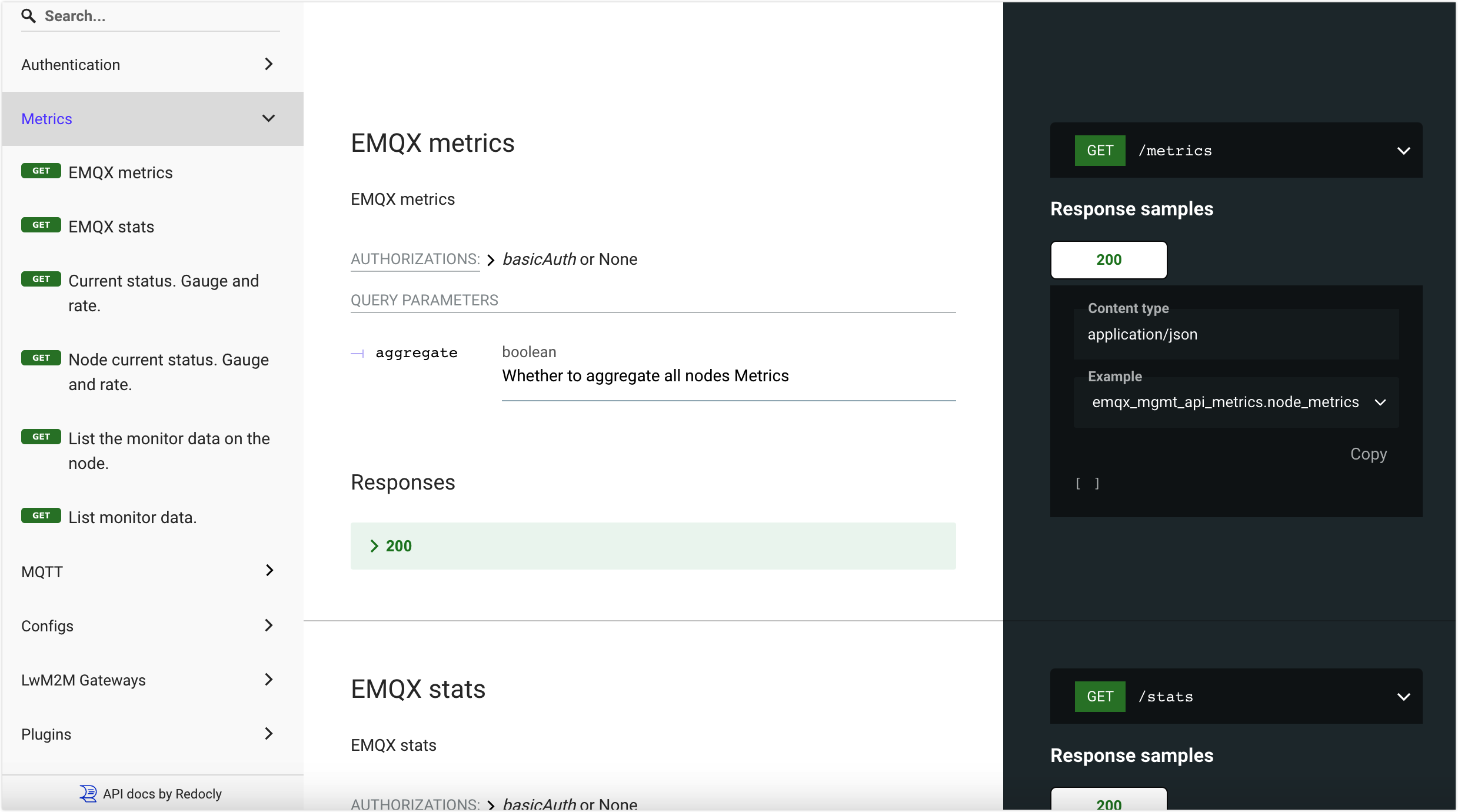
Get Monitoring Status via System Topics
EMQX periodically publishes messages about the running status, message statistics, and client online and offline events through system topics. Clients can subscribe to system topics by adding the prefix $SYS/ before the topic name. For more information on different types of system topics, see System Topic.
You can configure system topic settings on Dashboard. Click Management -> MQTT Settings from the left navigation menu. Select System Topic tab.
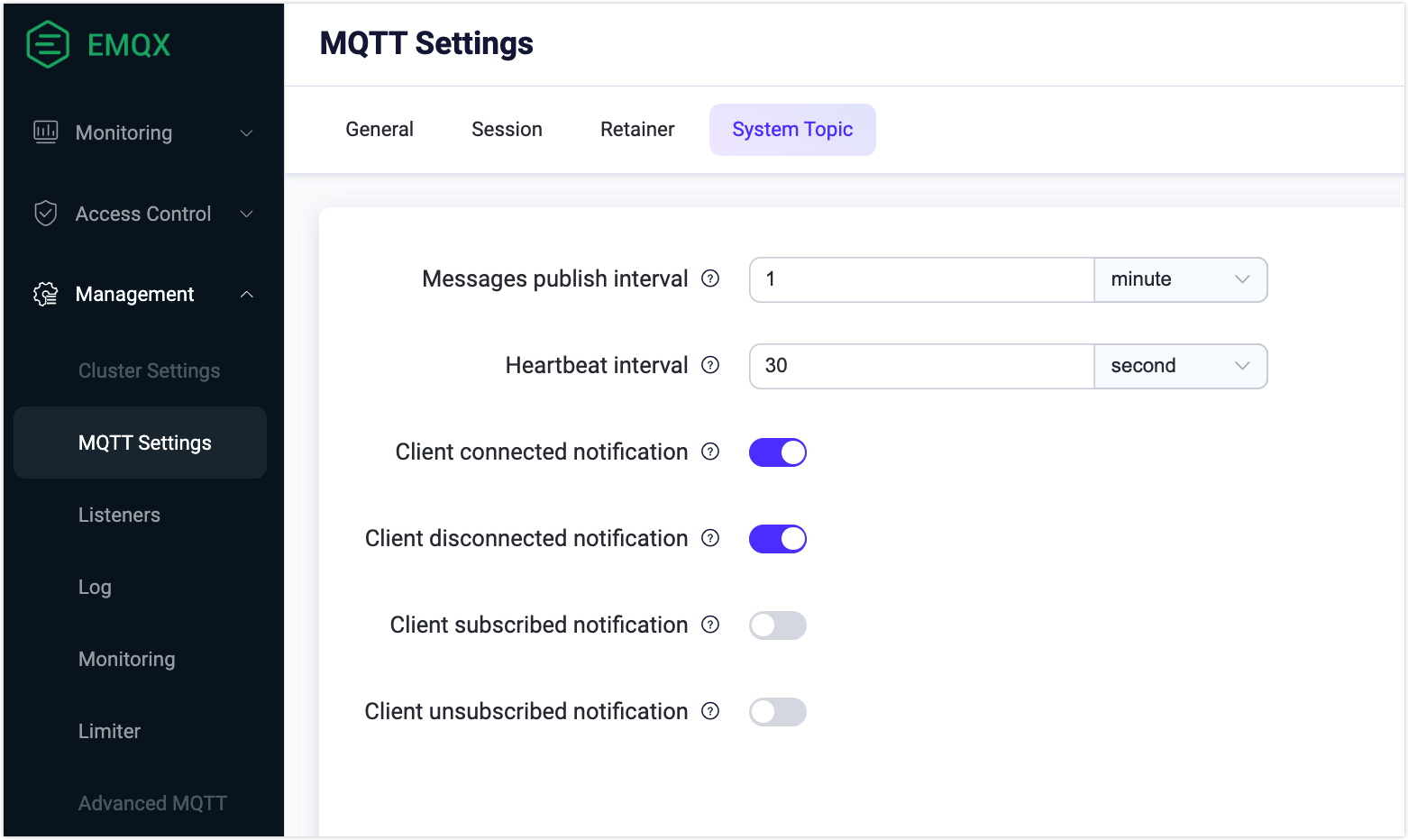
- Messages publish interval: Set the time interval for sending
$systopic. - Heartbeat interval: Set the time interval for sending heartbeat messages.
- Client connected notification: Enabled by default and event messages about client being connected will be published.
- Client disconnected notification: Enabled by default and event messages about client being disconnected will be published.
- Client subscribed notification: Disabled by default; When enabled, event messages about a client subscribing to a topic will be published.
- Client unsubscribed notification: Disabled by default; When enabled, event messages about a client unsubscribing to a topic will be published.